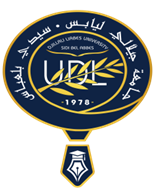Contribution à l'Etude des Adventices des Agrumeraies du Secteur Phytogéographique Oranais: Aspects Botanique, Ecologique et Agronomique
| dc.contributor.author | HANITET KARIMA | |
| dc.contributor.author | Encadreur: MEHDADI Zoheir | |
| dc.date.accessioned | 2024-10-06T09:50:23Z | |
| dc.date.available | 2024-10-06T09:50:23Z | |
| dc.date.issued | 2021-07-11 | |
| dc.description | Doctorat en Sciences | |
| dc.description.abstract | Résumé (en Français) : Contribution à l'Etude des Adventices des Agrumeraies du Secteur Phytogéographique Oranais: Aspects Botanique, Ecologique et Agronomique Ce travail consiste à inventorier et à caractériser sur le plan botanique, écologique et agronomique les adventices des agrumeraies du tell nord occidental de l’Oranie (ouest d’Algérie). Pour atteindre notre objectif, 200 relevés phytoécologiques ont été effectués sur 05 sites (Sig, Mohammadia, Tlemcen, Maghnia et Oran) en tenant compte de certaines variables agro-écologiques selon la méthode d’échantillonnage tour de champs. La flore recensée dans l’ensemble des sites de notre zone d’étude comprend 101 espèces d’adventices appartenant à 31 familles et 87 genres. Ces espèces se répartissent en 44 genres et 23 familles pour Sig, 71 genres et 27 familles pour Mohammadia, 77 genres et 31 familles pour Tlemcen, 69 genres et 30 familles pour Maghnia et 70 genres et 28 familles pour Oran. Les espèces inventoriées sont représentées essentiellement par les thérophytes dont le taux de présence est estimé à 74.5 %. Phytogéographiquement, les espèces recensées appartiennent notamment à l’élément méditerranéen avec un taux de présence de 43 %. Le traitement des données obtenues par l’analyse en composantes principales (ACP) montrent l’existence de trois groupes de sites étudiés distincts que ce soit pour les familles ou les types biologiques des adventices recensées. L’analyse factorielle des correspondances (AFC) a fait ressortir deux groupes d’espèces, présentant différentes corrélations aux sites d’étude ainsi qu’aux paramètres écologiques pris en compte. Les adventices inventoriés sont classées en fonction de leur fréquence et de leur abondance. L’analyse floristique quantitative montre que les espèces les plus fréquentes sont Avena sterilis, Oxalis cernua, Convolvulus arvensis et Cynodon dactylon. L’analyse de l’importance agronomique des espèces à partir de leur fréquence relative et de leur recouvrement moyen, a permis d’élaborer un diagramme d’infestation des espèces qui a fait ressortir 06 groupes d’espèces selon leur degré d’infestation. Les mots clés : Adventices ; Agrumeraies ; Relevés phytoécologiques ; Tell Nord Oranais ; Analyse Floristique, Analyse pédologique, Analyse agronomique, AFC, ACP. Abstract (en Anglais) : Contribution to the Study of the Weeds of the Citrus Plantations of the Phyto-geographical Sector of Oran: Botanical, Ecological and Agronomic Aspects This work consists of inventorying and characterizing botanically, ecologically and agronomically the weeds of citrus groves of the north-western tell of Oranian (western Algeria). To achieve our objective, 200 phytoecological surveys were carried out on 05 sites (Sig, Mohammadia, Tlemcen, Maghnia and Oran) taking into account certain agro-ecological variables according to the field tour sampling method. The flora identified in all the sites in our study area includes 101 weed species belonging to 31 families and 87 genera. These species are divided into 44 genera and 23 families for Sig, 71 genera and 27 families for Mohammadia, 77 genera and 31 families for Tlemcen, 69 genera and 30 families for Maghnia and 70 genera and 28 families for Oran. The inventoried species are mainly represented by the therophytes whose presence rate is estimated at 74.5%. Phytogeographically, the species listed belong in particular to the Mediterranean element with an occurrence rate of 43%. The processing of the data obtained by the principal component analysis (PCA) shows the existence of three groups of distinct study sites, whether for the families or biological types of the weeds identified. The factorial correspondence analysis (CFA) revealed two groups of species, presenting different correlations to the study sites as well as to the ecological parameters taken into account. The inventoried weeds are classified according to their frequency and their abundance. Quantitative floristic analysis shows that the most frequent species are Avena sterilis, Oxalis cernua, Convolvulus arvensis and Cynodon dactylon. The analysis of the agronomic importance of the species from their relative frequency and their average coverage, made it possible to develop a species infestation diagram which brought out 06 groups of species according to their degree of infestation. Keywords : Weeds; Citrus groves; Phytoecological surveys; Tell North Oranian; Floristic analysis, Soil analysis, Agronomic analysis, AFC, PCA. | |
| dc.identifier.uri | https://dspace.univ-sba.dz/handle/123456789/1744 | |
| dc.title | Contribution à l'Etude des Adventices des Agrumeraies du Secteur Phytogéographique Oranais: Aspects Botanique, Ecologique et Agronomique | |
| dc.type | Thesis |
